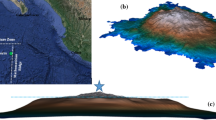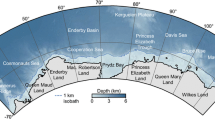Abstract
—This paper presents a crustal model derived from an Ocean Bottom Seismograph (OBS) study along the northern Vøring margin off Norway. The profile was acquired to map the crustal structure in the northernmost part of the Vøring Basin, and to link crustal models of the Lofoten and central Vøring Basin obtained by previous OBS studies. The Vøring margin, as well as the Lofoten margin to the north, was created by continental breakup between Norway and Greenland in late Paleocene-early Eocene. The rifting and continental breakup process were accompanied by intense extrusive and intrusive magmatic activities. The OBS data provide the whole crustal structure along the northern Vøring margin, in the area where the deep crustal structure cannot be resolved by conventional multichannel reflection data due to sill intrusions in the sedimentary sequence. The shallow part of the crustal model is characterized by up to 10 km thick sediments, a sequence of flood basalts and sill intrusions. The P-wave velocities in the flood basalts and sill intrusions are estimated to 5.0 km/s and 4.7–5.8 km/s, respectively. The model indicates an abrupt thickening of the upper crystalline crust from approx.3 km in the NE, to about 10 km towards the SE, with velocities of 6.0–6.2 km/s. The lower crustal velocities are not well resolved due to lack of clear refraction arrivals from the lower crust. However, the observed amplitude versus offsets are best explained by a model with a change in lower crustal velocities from 6.8 to 7.2 km/s beneath the Bivrost lineament. The modelling infers the presence of a lower crustal reflector beneath the lineament, which represents the landward continuation of the Bivrost lineament. Reflection arrivals from the Moho reveal a Moho depth of 23 km in the middle of the profile and 18– 20 km in the northeastern part of the profile. A 370 km long crustal section from the central part of the Vøring Basin to the Lofoten margin, obtained by the results of this study and previous OBS studies, shows a simple thinned continental crust on the Lofoten margin, and a high velocity lower crust underlying an upper crust of varying thickness in the Vøring Basin. The transition between these structures is situated beneath the Bivrost lineament in the lower crust, and beneath the basement high about 40 km south of the lineament in the upper crust.
Similar content being viewed by others
Author information
Authors and Affiliations
Additional information
Received February 20, 1997, accepted August 30, 1997
Rights and permissions
About this article
Cite this article
Kodaira, S., Mjelde, R., Shiobara, H. et al. Structure of a Volcanic Continental Margin Derived from Ocean-bottom Seismographic Data: The Northern Vøring Margin, off Norway. Pure appl. geophys. 152, 1–21 (1998). https://doi.org/10.1007/s000240050138
Published:
Issue Date:
DOI: https://doi.org/10.1007/s000240050138




